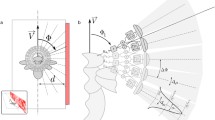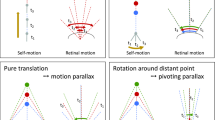Abstract
We generated panoramic imagery by simulating a fly-like robot carrying an imaging sensor, moving in free flight through a virtual arena bounded by walls, and containing obstructions. Flight was conducted under closed-loop control by a bio-inspired algorithm for visual guidance with feedback signals corresponding to the true optic flow that would be induced on an imager (computed by known kinematics and position of the robot relative to the environment). The robot had dynamics representative of a housefly-sized organism, although simplified to two-degree-of-freedom flight to generate uniaxial (azimuthal) optic flow on the retina in the plane of travel. Surfaces in the environment contained images of natural and man-made scenes that were captured by the moving sensor. Two bio-inspired motion detection algorithms and two computational optic flow estimation algorithms were applied to sequences of image data, and their performance as optic flow estimators was evaluated by estimating the mutual information between outputs and true optic flow in an equatorial section of the visual field. Mutual information for individual estimators at particular locations within the visual field was surprisingly low (less than 1 bit in all cases) and considerably poorer for the bio-inspired algorithms that the man-made computational algorithms. However, mutual information between weighted sums of these signals and comparable sums of the true optic flow showed significant increases for the bio-inspired algorithms, whereas such improvement did not occur for the computational algorithms. Such summation is representative of the spatial integration performed by wide-field motion-sensitive neurons in the third optic ganglia of flies.
Similar content being viewed by others
References
Adelson EH, Bergen JR (1985) Spatiotemporal energy models for the perception of motion. J Opt Soc Am A 2: 284–299
Barnett PD, Nordström K, O’Carroll D (2010) Motion adaptation and the velocity coding of natural scenes. Curr Biol 20: 994–999
Borst A, Haag J (2002) Neural networks in the cockpit of the fly. J Comp Physiol A 188: 419–437
Borst A, Egelhaaf M, Haag J (1995) Mechanisms of dendritic integration underlying gain control in fly motion-sensitive neurons. J Comput Neurosci 2: 5–18
Borst A, Haag J, Reiff D (2010) Fly motion vision. Annu Rev Neurosci 33: 49–70
Bouguet J-Y (1999) Pyramidal implementation of the Lucas– Kanade feature tracker. OpenCV documentation. Microprocessor Research Lab, Intel Corporation, Santa Clara, CA
Clifford CWG, Ibbotson MR (2003) Fundamental mechanisms of visual motion detection: models, cells and functions. Prog Neurobiol 68: 409–437
Clifford CWG, Langley K (1996) A model of temporal adaptation in fly motion vision. Vis Res 36: 2595–2608
Collett TS, Land MF (1975) Visual control of flight behaviour in the hoverfly, Syritta pipiens L. J Comp Physiol A 99: 1–66
Dahmen HJ, Franz MO, Krapp HG (2001) Extracting egomotion from optic flow: limits of accuracy and neural matched filters. In: Zanker J, Zeil J (eds) Motion vision—computational, neural and ecological constraints. Springer, Berlin, pp 143–168
Dickson WB, Straw AD, Dickinson MH (2008) Integrative model of Drosophila flight. AIAA J 46: 2150–2164
Dror RO, O’Carroll DC, Laughlin SB (2001) Accuracy of velocity estimation by Reichardt correlators. J Opt Soc Am A 18: 241–252
Egelhaaf M, Borst A (1993) Movement detection in arthropods. In: Miles FA, Wallman J (eds) Visual motion in the stabilization of gaze. Elsevier, Amsterdam, pp 3–27
Egelhaaf M, Borst A, Reichardt W (1989) Computational structure of a biological motion-detection system as revealed by local detector analysis in the fly’s nervous system. J Opt Soc Am A 6: 1070–1087
Egelhaaf M, Kern R, Krapp HG, Kretzberg J, Kurtz R, Warzecha A (2002) Neural encoding of behaviourally relevant visual-motion information in the fly. Trends Neurosci 25: 96–102
Franceschini N, Riehle A, Le Nestour A (1989) Directionally selective motion detection by insect neurons. In: Stavenga DG, Hardie RC (eds) Facets of vision. Springer-Verlag, Berlin, pp 360–390
Franz MO, Krapp HG (2000) Wide-field, motion sensitive neurons and matched filters for optic flow fields. Biol Cybern 83: 185–197
Fry SN, Sayaman R, Dickinson MH (2003) The aerodynamics of free flight maneuvers in Drosophila. Science 300: 495–498
Grosse I (1996) Estimating entropies from finite samples. In: Freund JA (eds) Dynamik—evolution—strukturen. Verlag Dr. Köster, Berlin
Haag J, Denk W, Borst A (2004) Fly motion vision is based on Reichardt detectors regardless of the signal-to-noise ratio. Proc Natl Acad Sci USA 101: 16333–16338
Harris RA, O’Carroll DC, Laughlin SB (1999) Adaptation and the temporal filter of fly motion detectors. Vis Res 39: 2603–2613
Harris RA, O’Carroll DC, Laughlin SB (2000) Contrast gain reduction in fly motion adaptation. Neuron 28: 595–606
Hassenstein B, Reichardt W (1956) Systemtheoretische analyse der Zeit-, Reihenfolgen-, und Vorseichenauswertung bei der Berwegungsperzeption des Rüsselkäfers Chlorophanus. Z Naturforsch 11: 513–524
Hausen K (1982) Motion sensitive interneurons in the optomotor system of the fly. I. The horizontal cells: structure and signals. Biol Cybern 45: 143–156
Hausen K (1982) Motion-sensitive interneurons in the optomotor system of the fly. II. The horizontal cells: receptive field organization and response characteristics. Biol Cybern 46: 67–79
Hausen K, Egelhaaf M (1989) Neural mechanisms of visual course control in insects. In: Stavenga DG, Hardie RC (eds) Facets of vision. Springer-Verlag, Berlin, pp 391–424
Herzel H, Grosse I (1995) Measuring correlations in symbols sequences. Physica A 216: 518–542
Hesselberg T, Lehmann FO (2007) Turning behavior depends on frictional damping in the fruit fly Drosophila. J Exp Biol 210: 4319–4334
Humbert JS, Hyslop AM (2010) Bio-inspired visuomotor convergence. IEEE Trans Robot 26: 121–130
Hyslop AM, Krapp HG, Humbert JS (2010) Control theoretic interpretation of directional motion preferences in optic flow processing interneurons. Biol Cybern 95(5): 413–430
Kirschfeld K (1991) An optomotor control system with automatic compensation for contrast and texture. Proc R Soc Lond B0 246: 261–268
Koenderink JJ, van Doorn AJ (1987) Facts on optic flow. Biol Cybern 56: 247–254
Krapp HG, Hengstenberg B, Hengstenberg R (1998) Dendritic structure and receptive-field organization of optic flow processing interneurons in the fly. J Neurophysiol 79: 1902–1917
Laughlin SB (1976) Neural integration in the first optic neuropile in dragonflies. IV. Interneuron spectral sensitivity and contrast enconding. J Comp Physiol 112: 199–211
Laughlin S (1984) The roles of parallel channels in early visual processing by the arthropod compound eye. In: Ali MA (eds) Photoreception and vision in invertebrates. Plenum Press, New York, pp 457–481
Lipetz LE (1971) The relation of physiological and psychological aspects of sensory intensity. In: Loewenstein WR (eds) Handbook of sensory physiology. Springer, Berlin, Heidelberg, New York, pp 192–225
Lucas BD, Kanade T (1981) An iterative image registration technique with an application to stereo vision. In: Proceedings of the 7th international joint conference on artificial intelligence, Canada, pp 674–679
Maddess T, Laughlin SB (1985) Adaptation of the motion sensitive neuron H1 is generated locally and governed by contrast frequency. Proc R Soc Lond B 225: 251–275
McCarthy C, Barnes N (2004) Performance of optical flow techniques for indoor navigation with a mobile robot. In: Proceedings of IEEE international conference on robots & automation, New Orleans, LA, pp 5093–5098
Naka KI, Rushton WAH (1966) S-potentials from luminosity units in retina of fish (Cyprinidae). J Physiol (Lond) 185: 587–599
Reiser MB, Humbert JS, Dunlop MJ, del Vecchio D, Murray RM, Dickinson MH (2004) Vision as a compensatory mechanism for disturbance rejection in upwind flight. Proc Am Control Conf 1: 311–316
Rind FC (1996) Intracellular characterization of neurons in the locust brain signaling impending collision. J Neurophysiol 75: 986–995
Shoemaker PA, O’Carroll DC, Straw AD (2005) Velocity constancy and models for wide-field motion detection in insects. Biol Cybern 93: 275–287
Srinivasan MV, Guy RG (1990) Spectral properties of movement perception in the dronefly Eristalis. J Comp Physiol A 166: 287–295
Srinivasan M, Zhang SW (2004) Visual motor computations in insects. Annu Rev Neurosci 27: 679–696
Srinivasan MV, Zhang SW, Chandrashekara K (1993) Evidence for two distinct movement-detecting mechanisms in insect vision. Naturwissenschaften 80: 38–41
Srinivasan MV, Zhang SW, Lehrer M, Collet TS (1996) Honeybee navigation en route to the goal: visual flight control and odometry. J Exp Biol 199: 237–244
Straw AD, Rainsford T, O’Carroll D (2008) Contrast sensitivity of insect motion detection to natural images. J Vis 8: 1–9
Tolhurst DJ, Tadmor Y, Chao T (1992) Amplitude spectra of natural images. Ophthalmol Physiol Opt 12: 229–232
van Santen JPH, Sperling G (1984) Temporal covariance model of human motion perception. J Opt Soc Am 1: 451–473
Wolf-Oberhollenzer F, Kirschfeld K (1994) Motion sensitivity in the nucleus of the basal optic root of the pigeon. J Neurophysiol 71: 1559–1573
Author information
Authors and Affiliations
Corresponding author
Rights and permissions
About this article
Cite this article
Shoemaker, P.A., Hyslop, A.M. & Humbert, J.S. Optic flow estimation on trajectories generated by bio-inspired closed-loop flight. Biol Cybern 104, 339–350 (2011). https://doi.org/10.1007/s00422-011-0436-8
Received:
Accepted:
Published:
Issue Date:
DOI: https://doi.org/10.1007/s00422-011-0436-8




